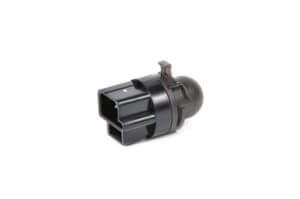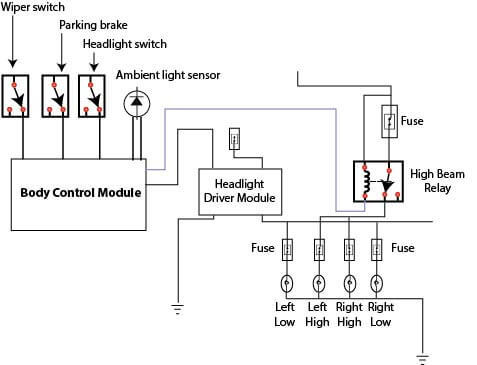No headlights Trailblazer Envoy
Diagnose and fix no headlights Trailblazer Envoy
The no headlights Trailblazer Envoy extends well beyond just those GM models and there is a recall for some of those. If you own a Chevrolet Trailblazer or GMC Envoy and have a no headlights issue, this article is for you. The no headlights Trailblazer Envoy can be caused by several different components and it’s a complicated system so you’ll have to understand how it works before you can fix it.
Headlight recall
GM has issued a recall on the headlight driver module in many GM vehicles, but it does NOT cover all vehicles that use a headlight driver module. For more information read this bulleting
GM headlight driver module recall
The are many other articles about the headlight driver module issue, but this problem extends back into 2002 GM vehicles and many of those aren’t included in the recall.
Trailblazer Envoy Headlights
In the old days you flipped the headlight switch and the switch routed power to the headlights. It hasn’t worked that way for at least 10 years now. Today, the headlight switch doesn’t really switch power to the headlights. Instead, the headlight switch acts as a signaling method to tell the body control module (BCM) to turn on the headlights. If that’s all that’s involved in your Tralblazer Envoy, this would be a short story; but it’s NOT.
Like many other car makers, GM had to find a way to provide daytime running lights (DRL) for safety while achieving higher MPG. Running headlights takes power and power cuts down on gas mileage. In the early days of DRL, car makers installed a resistor module to cut down on headlight brightness. But a resistor uses power, so it solved the DRL issue but not the gas mileage problem.
In the early 2000 models, GM came up with “better” idea. Instead of using a resistor to provide decrease DRL illumination, they decided to pulse the power to the headlight bulbs with a pulse width modulated (PWM) method.
Pulse width modulated headlights
In a PWM system, power is provided to a power transistor and the circuit is turned on and off. The amount of time the ground circuit is either on or off is determined by a solid state device and software. If you only provide power to a headlight half the time, you’ll get half the brightness and use half the power. Ah ha. GM struck gold
Trailblazer Envoy headlights have three modes
• Reduced Intensity Mode — This mode saves power and improves gas mileage by pulsing the headlights on only 81% of the time for DRL use.
• Full Intensity Mode — The full intensity mode is activated when you turn on your headlights manually, operate your wipers (if your vehicle is equipped with Wiper Activated Headlight (WAH) feature or the auto mode. In this mode, the headlights receive full power with no PWM.
• Off Mode — When the headlight switch is off, wipers are off and no other criteria are met. PWM in this mode is 0% on.
Trailblazer Envoy headlights turn on in 3 different ways
1) You turn on your headlights manually. The BCM provides low voltage low current power to the headlight switch. When you turn on your headlights manually, the headlight switch closes contacts and the BCM detects the request for headlights and provides 100% PWM duty cycle to the the headlight driver module (HDM).
2) You leave the headlight switch in the AUTO position. This is called the Automatic Lamp Control (ALC) feature. When you start the vehicle, the

Ambient light sensor
BCM checks the input from the ambient light sensor. If the BCM sees that it’s daylight AND the parking brake is not on, it assumes you’re planning to drive in daylight and turns on the DRL. The BCM powers the HDM at 81% PWM to run your headlights at DRL illumination levels. If the BCM determines the ambient light level input is low, it turns on the headlights at full intensity mode with 100% PWM power to the HDM.
3) You turn on your wipers and your vehicle is equipped with WAH. The BCM sees wiper activation and checks to see if the transmission is in a drive gear. Next, it checks for at least three wipes of the blades and starts a 35 second timer. If the wipers are still turned on and the ambient light sensor input indicates daylight conditions, the BCM will switch to DRL mode and provide 81% PWM to the HDM. If the ambient light sensor indicates darkness, the BCM will provide full power to the HDM for full illumination mode.
High beam operation
When you turn on your high beams, the BCM sees the request from the dimmer switch and grounds the control coil in the high beam headlight relay. The power supply to the high beam headlight relay and power to the HDM are supplied by the battery.
What goes wrong with Trailblazer Envoy headlights
The BCM is the brains behind the outfit. It relies on inputs from the headlight and dimmer switch, ambient light sensor, parking brake switch, transmission range selector and wiper switch. Then it determines which mode to command and sends the appropriate PWM ground to the HDM.
Diagnose no headlights Trailblazer Envoy
If you have a bidirectional scan tool, start by manually commanding a low beam ON command from the scan tool. If the headlights don’t come on, check the headlight fuses and power to the HDM (see headlight wiring diagram below).
Remove the HDM from the underhood fuse block (looks just like a relay). Apply battery power to cavity 4 in the HDM socket—this bypasses the BCM and HDM and supplies power directly to both low beams. The headlights should come on. If they don’t you have a Fuse, wiring harness or ground issue to the front low beams.
Check for power on cavity #2 in the HDM socket. If no power, check fuse #53. Turn the headlight switch to ON with key in RUN position and check for power at cavity #5 in the HDM socket. Check for good ground in cavity 6 of the HDM socket. If you see all those readings, replace the HDM. It’s a common failure item.
If you don’t see those readings, the problem lies in the BCM or inputs.

GM PWM headlight wiring diagram
©, 2017 Rick Muscoplat
Posted on by Rick Muscoplat